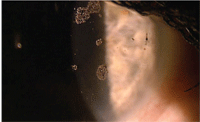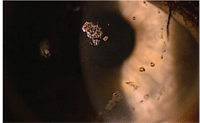 Our focus with this column is to maximize contact lens wear success and to offer our patients the advantages of clear vision without the need for glasses. This patient-centric approach requires an increased effort on the practitioner’s part to optimize ocular health, lens design and lens care. In return, you create loyalty and a strong patient base.
Our focus with this column is to maximize contact lens wear success and to offer our patients the advantages of clear vision without the need for glasses. This patient-centric approach requires an increased effort on the practitioner’s part to optimize ocular health, lens design and lens care. In return, you create loyalty and a strong patient base.
We have seen that commoditization of contact lenses and consumerism have resulted in a potentially problematic misperception of contact lenses by a significant portion of the public (e.g., the assumption that contact lenses can be dispensed without the intervention of an eye care professional). However, we, as practitioners, have an opportunity to help patients understand the medical nature of contact lenses and the importance of regular eye care through education.
Contact Lens Wear and Care
In order to understand patients’ wearing experience, the eye care practitioner must perform a deeper investigation into their wear and care habits. When discussing lens wear with patients, be certain to use a non-judgmental tone and remain conversational. The patient will be more likely to tell us how they are truly caring for their lenses; patients rarely want to tell us they are doing something incorrectly.
Aside from patient compliance, other challenges can exist. Eye care practitioners may inadvertedly give mixed messages, which can lead to patient confusion. A recent study indicated that 16% of practitioners recommended two-week contact lenses to be worn for a month.1
Patients may be passive about contact lens wear because we may be passive about re-educating more experienced wearers. We see that our long-term contact lens wearing patients are the ones more likely to stray from our professional contact lens care recommendations.2
How to Encourage Compliance
Consider having your patients bring their contact lens solutions and lens cases to office visits. This will help provide a more complete picture of whether patients are using the recommended solutions while also showing you the condition of their contact lens cases. Be warned, you may notice things you didn’t expect to see: the presence of biofilms inside of the lens cases is common. Their existence is affected by a number of factors and may increase the risk of adverse events.3,4
We first started asking patients to bring in their lens cases and solution when we noticed a growing trend of long-term successful lens wearers complaining about mild to moderate comfort issues. What we found was that our patients were switching solutions and taking poor care of their cases. We pinpointed the cause of decreased comfort and addressed it proactively. Through this exercise, you help make your patients responsible for their lens care habits and provide a platform for educating them on proper care. As an added bonus, you set your practice apart as one that emphasizes contact lenses and maximizing patient outcomes.
The Compliance Toolbox
There are a number of tools that can help the eye care practitioner increase patient compliance efforts. LensAlert is a unique product that keeps track of the age of the contact lens case and the contact lenses. It counts down from the number of days that a person should keep their contact lenses and case, per the provider’s instructions. When the number reaches zero, it is time to change to a new lens and/or case.5
Contact lens manufacturers have also started creating reminders in an attempt to increase compliance efforts. Acuminder (Vistakon) allows patients to register for reminders to change their contact lenses.6 Another industry effort, eyeVIP (Alcon), attempts to increase compliance by sending periodic reminders to patients on proper care for their contact lenses. (Note: If interested, contact the respective sales representatives for further information.)
Finally, eye care practitioners have access to unique tools in the exam room to better educate patients on the importance of proper contact lens wear. With slit lamp photography, you have the ability to capture both pictures and videos. I typically video record the anterior segment examination, particularly in cases of contact lens abuse. Showing patients the results of their contact lens abuse serves as a valuable educational tool for patients to help increase compliance efforts.
Communication is the Key
There is a critical moment during an appointment where we should incorporate all our findings, and combined them with our knowledge base and experience, to educate our patients on best wear and care for their contatct lenses. But the question remains: What resonates with patients and what factors should we be focusing on to maximize contact lens compliance efforts?
In a recent study, more than 1,600 patients were questioned on compliance habits. Researchers compared differences in the way compliant vs. noncompliant lens wearers answered questions. Patients were asked about their level of agreement with the following statement: “I follow the recommended replacement schedule because it leads to fewer problems with my eyes.” In response, 85% of compliant patients and 38% of noncompliant either agreed or strongly agreed with this statement.1
There was one statement that surprisingly drew the same reaction between both groups of contact lens wearers. Patients were asked about their level of agreement with the following statement: “Uncomfortable lenses make me more likely to follow the recommended replacement schedule.” In response, 85% of compliant patients and 83% of noncompliant patients either agreed or strongly agreed with this statement.1 Comfortable contact lens wear seems to be important to both compliant and noncompliant lens wearers.
We can use this point and leverage it when describing compliant lens wear and care to our patients. By describing the replacement schedule and the contact lens care that we are recommending as maximizing comfortable lens wear, we have a communication point that we know resonates with most lens wearers.
A Case Study

1. Excessive deposits on the left contact lens.
A 50-year-old female came in for her annual exam, approximately 20 months after her last visit. She wanted contact lenses and was upset that she needed an appointment to update her prescription. She came in wearing a two-month old two-week disposable modality lens. Her entering visual acuity with the lenses was 20/30 O.U. Over-refraction with the contact lenses on yielded no improvement in acuity.
Upon physical examination of the contact lenses, it was evident that excessive deposits on the contact lenses were the reason for the decreased vision (see photos). A video of the contact lens examination was captured with a slit lamp video camera. We showed the videos to our patient and she quickly realized that what she was doing was not in her best interest. She denied sleeping in her contact lenses.
In discussing the proper wear of her contact lenses, we re-educated her about the importance of replacing her contact lenses twice a month. We also discussed that many patients who wear their lenses the way she does experience similar symptoms. I explained that many individuals typically experience a decrease in comfort over their wear time, potentially dropping out of lens wear.

2. Excessive deposits on the right contact lens.
After her visit, she purchased a one-year supply of lenses to take advantage of the cost savings and immediately scheduled her twice-monthly contact lens replacement days into her smart phone.
As this case illustrates, we have the tools to improve contact lens compliance with each of our patients. By introducing new ways to encourage compliance, we can optimize the chances of success for our contact lens wearers.
1. Dumbleton K, Woods C, Jones L, et al. Patient and Practitioner Compliance With Silicone Hydrogel and Daily Disposable Lens Replacement in the United States. Cornea. 2009 Jul;35(4):164-71.
2. Survey of 1,000 patients. MSW attitude and usage survey. Market Performance Group LLC, November 2008.
3. Furuhata K, Ishizaki N, Kawakami Y, Fukuyama M. Bacterial contamination of stock solutions in storage cases for contact lens, and the disinfectant-resistance of isolates. Biocontrol Sci. 2010 Sep;15(3):81-5.
4. Szczotka-Flynn LB, Pearlman E, Ghannoum M. Microbial contamination of contact lenses, lens care solutions, and their accessories: a literature review. Eye Contact Lens. 2010 Mar;36(2):116-29.
5. LensAlert. Available at:
www.lensalert.com (Accessed March 2011).
6. MyAcuvue Acuminder. 2011 Jan. Available at:
www.acuvue.com/home-acuminder.htm (Accessed March 2011).


